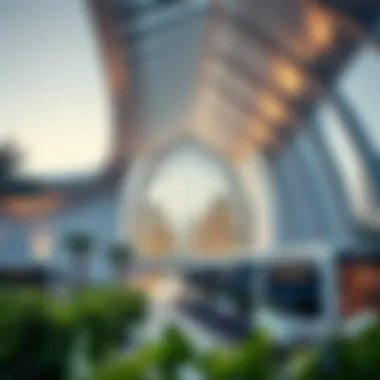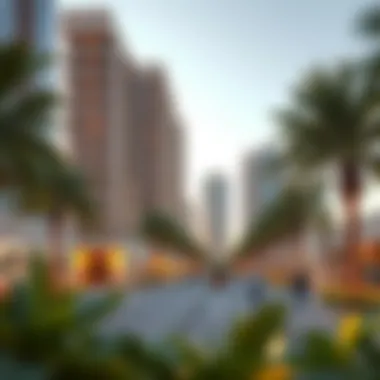Exploring the Garden Metro Station: A Key Transit Hub in Dubai


Intro
The Garden Metro Station in Dubai, not merely a stop on the rail line, embodies the city's ambition and growth. This relatively recent addition to the metropolitan skyline serves as a vital link not just for residents but also for those exploring the bustling urban landscape. As the city’s transport system expands, so does the significance of this station, marking it as an essential hub of activity and connection.
The station’s architectural design reflects a blend of modern aesthetics and functionality, a true representation of what Dubai stands for today. Not only does it facilitate the daily commute for thousands, but it is also surrounded by neighborhoods brimming with potential. For property investors and expatriates alike, understanding the forces at play around this station offers a treasure map to opportunities that could greatly influence their ventures in the Dubai real estate market.
Overview of the Garden Metro Station
In Dubai, the Garden Metro Station is not just a stop along the line; it is pivotal in shaping the city's transport framework. This station provides a direct link to key areas, facilitating ease of movement for residents and visitors alike. As Dubai continues to grow, the importance of this station is magnified, particularly in light of the urban sprawl and increasing commuter demands. It serves as a lifeline for thousands, connecting them to their daily routes.
Historical Background
The inception of the Garden Metro Station marks a significant chapter in Dubai's transit history. Although plans for an extensive metro began in the early 2000s, the station itself was conceptualized to meet the unique requirements of the burgeoning population. Construction began in tandem with the overall metro system, aiming to alleviate traffic congestion that plagued the city. It opened its doors to the public with the completion of the Red Line, a watershed moment that set a new trajectory for urban mobility.
Architectural Design
The architectural aesthetics of the Garden Metro Station reflect a harmonious blend of modernity and functionality. With sleek lines and innovative use of space, the design intentionally accommodates a high volume of commuters. The broad platforms and spacious concourses are designed not just for utility but also for a pleasant user experience. Natural light floods the underground areas, thanks to thoughtfully placed skylights, creating a friendly ambiance. The station is equipped with amenities that cater to the comfort of travelers, from seating areas to retail kiosks.
Operational Details
Operational effectiveness is central to the Garden Metro Station's importance. Serving as a major hub within the Dubai Metro's extensive network, it operates on a timetable that caters to peak hours, ensuring that commuters have access when they need it the most. The station is well-maintained, with regular checks and upgrades to ensure smooth operations. Furthermore, it offers support for various ticketing options, making it accessible for both daily commuters and occasional visitors.
"The Garden Metro Station is a cornerstone of Dubai's commitment to sustainable transport solutions, setting the standard for efficiency and modern travel."
In summary, the Garden Metro Station embodies the spirit of connectivity in Dubai. With its robust historical roots, distinctive design, and operational efficiencies, it stands out as an essential component in the city’s expansive transport system.
Significance in Transport Network
The Garden Metro Station plays a crucial role in the broader transport ecosystem of Dubai, functioning as a vital link not just for daily commuters but also for tourists and local businesses alike. Understanding the station's significance here demands a closer look at its interconnections, operational features, and overall impact on commuting times.
Integration with Other Transit Options
A key aspect of the Garden Metro Station is how well it integrates with other transit methods. Located within a bustling urban environment, the station acts as a connecting hub where several forms of transportation converge.
Firstly, it offers seamless access to bus services that crisscross the city, allowing commuters to transfer effortlessly between the metro and local buses. For instance, many bus routes serve popular residential areas and commercial zones, which enhances mobility and convenience.
Transport is not limited to buses. Taxis and ride-sharing services, like Uber and Careem, frequently operate around the station, making pick-up and drop-off a breeze for travelers. This multi-modal integration ensures that whether one is heading to the office, the mall, or even the airport, a multitude of options is available right at their fingertips.
"The Garden Metro Station's strategic location makes it a linchpin in Dubai’s transport network, enabling smooth transitions across various transit modes."
Impact on Commuting Times
The operational efficiency of the Garden Metro Station has a significant influence on commuting durations for its users. By providing a direct metro line through the heart of the city, the station alleviates traffic congestion that is often synonymous with urban living. Instead of navigating through packed roads, commuters can hop on a train and reach their destinations in a fraction of the time, especially during peak hours.
Research has shown that for many, the metro cuts down travel times by as much as 30-40%. Not only does this save time, but it also enhances productivity—workers can arrive at their workplaces fresh and ready to tackle the day.


Additionally, the state-of-the-art design and technology of the metro trains facilitate rapid and consistent service. With trains running every few minutes, the uncertainty of travel is reduced, allowing commuters to plan their schedules more accurately.
Real Estate Influence
The real estate landscape around the Garden Metro Station is more than just a byproduct of the transit system; it acts as a catalyst for economic potential and property value enhancement. This metro station provides an efficient means of transport, giving rise to a new dynamic in real estate development and investment. For buyers, investors, and expatriates, understanding these influences is critical in making informed decisions regarding property acquisition and asset allocation.
When metro stations open, they often lead to increased accessibility that translates into heightened demand for housing and commercial spaces in that vicinity. Investors keen on capital growth and stability often look at these transit nodes as prime locations worthy of careful consideration. The interplay of convenience and sustainability cannot be understated in the decisions made by those navigating this fast-paced market.
Property Values in Surrounding Areas
Since the Garden Metro Station has commenced operations, property values in its surrounding neighbourhoods have experienced noticeable shifts. Reports indicate that residential developments close to the station have observed a rise in their market value. This demonstrates a classic case where transport link enhancement correlates positively with real estate values.
- Residential apartments, particularly those within walking distance of the station, have become highly sought after. Their prime location offsets commute times, making them more attractive to both local and expatriate buyers.
- Properties with direct metro access cater to young professionals and families alike, positioning them favorably against competitors in other regions of Dubai.
Real estate analysts observe that properties near Garden Metro Station are witnessing:
- An average price increase of around 15% post-opening.
- Higher rental yields estimated at 20% in comparison to less accessible locales.
Such trends illustrate the immediate impact a well-placed transit hub can have on the local property market.
Market Trends Post-Station Opening
In the wake of the station's opening, market trends are indeed revealing. The upsurge in demand for the surrounding real estate has not just led to increasing prices. It has also sparked a wave of new developments and renovations, as property owners and developers scramble to capitalize on rising interest. The anticipated foot traffic around metro stations tends to attract certain types of establishments, which in turn raises the value of nearby properties.
Key takeaways in market trends post-opening include:
- Increased Development Activity: New mixed-use developments are emerging, integrating residential, retail, and office spaces to form vibrant communities.
- Shift in Buyer Preferences: A noticeable trend is the preference for properties that offer immediate access to public transport, especially among expatriates and young professionals seeking convenience.
- Evolving Commercial Landscape: Retail spaces are adapting, with increased leasing activity as businesses look to tap into the surge of commuters.
With each of these shifts, it's clear that the presence of the Garden Metro Station is fostering growth in more ways than one. A prudent investor will recognize that an optimal blend of strategic location and robust transport infrastructure can lead to profitable outcomes in Dubai's evolving real estate environment.
Neighborhood Insights
Understanding the neighborhoods surrounding the Garden Metro Station unveils a tapestry of advantages for various stakeholders, particularly investors and expatriates. The strategic placement of the station plays a crucial role in enhancing accessibility and livability. With the rapid expansion of Dubai's urban areas, these neighborhoods have evolved into attractive spots for both residential and commercial purposes. Not only do they provide a vibrant community life, but they also contribute significantly to the local economy.
Residential Options Nearby
The area surrounding Garden Metro Station boasts a diverse range of residential options, catering to varying preferences and budgets. From high-end apartments in luxurious complexes such as The Residences at Dubai Marina, to affordable housing that appeals to young professionals and families, there is something for everyone.
Furthermore, many residential projects are strategically designed with proximity to the metro station, ensuring that commuting remains hassle-free. For instance, residents of Al Furjan and Discovery Gardens have easy access to the station, providing a seamless connection to the city center and beyond. This connection not only enriches the lifestyle of the inhabitants but also enhances the property values in these areas, making them attractive investments.
"Investing near public transport networks typically leads to increased property value due to demand for accessibility."
Commercial Developments


With a surge in population and a vibrant economy, the commercial landscape near the Garden Metro Station is flourishing. Establishments range from gleaming office towers to charming retail spaces, catering to the needs of both residents and commuters. Well-known developments like Ibn Battuta Mall and Mall of the Emirates are merely a short metro ride away, attracting thousands with their shopping, dining, and entertainment options.
This growth in commercial developments is pivotal for local businesses and investors alike, creating opportunities and potential for lucrative returns. As more companies recognize the benefits of being near a major transit hub, the competition for commercial space intensifies. Investors looking at commercial properties must consider factors like accessibility and proximity to residential areas, as these elements significantly influence customer footfall.
Amenities within Proximity
Accessibility to various amenities is a significant draw for residents living near the Garden Metro Station. From schools and parks to healthcare facilities, the area offers a comprehensive range of services that enhance the quality of life.
For families, having reputable schools such as Jebel Ali School nearby is a major advantage. There are also numerous parks and green spaces for recreation, like Al Barsha Park, which are important for community engagement and personal well-being.
Healthcare is not neglected either; clinics and hospitals, such as Saudi German Hospital and Mediclinic, provide residents with the necessary medical facilities within easy reach. On top of that, ample dining options, shopping centers, and entertainment venues ensure that life remains vibrant and varied.
In summary, the neighborhoods surrounding the Garden Metro Station are dynamic and multifaceted. They present immense potential for both living and investment. As the area continues to develop, stakeholders stand to benefit significantly from the ongoing changes.
Benefits for Expatriates
The Garden Metro Station brings several benefits that cater specifically to expatriates living in and around Dubai. As the expatriate community flourishes in this cosmopolitan city, having accessible transportation remains crucial for efficient daily living. Understanding these benefits gives expatriates a clearer idea of their urban experience and helps investors gauge the potential of nearby developments.
Accessibility to Workplaces
When it comes to convenience, the Garden Metro Station serves as a gateway for many expatriates to access workplaces throughout Dubai. For example, the station connects seamlessly to major business districts like the Dubai International Financial Centre and the Jebel Ali Free Zone. This means that expatriates working in diverse sectors can sidestep the notorious traffic jams that plague the city.
Commuters can reach their offices in a shorter amount of time, as Metro trains run frequently throughout the day and evening. This time efficiency translates to a more balanced work-life environment, something every expatriate values. Additionally, with the rising trend of remote work, even employees working from home appreciate the option to take the Metro for occasional meetings without the hassle of parking.
"In a city where every minute counts, the Metro's efficiency is a game changer for expatriates, allowing them to maximize personal and professional time alike."
Cultural and Recreational Offerings
The area surrounding the Garden Metro Station brims with cultural and recreational opportunities, making it an attractive location for expatriates. After work hours or on weekends, expatriates have the chance to immerse themselves in local culture or seek leisure activities just a few steps away from the Metro. Places like the Dubai Marina and Jumeirah Beach are not far off and easily accessible via the Metro.
Moreover, cultural centers and art galleries are sprinkled throughout the vicinity, showcasing local artists and international exhibits alike. These venues not only serve as hotspots for upcoming events but also facilitate community engagement where expatriates can connect with locals and other expatriates.
In addition, the dining scene around the station offers a plethora of choices that reflect the multicultural tapestry of Dubai. From traditional Middle Eastern cuisine to modern fusion restaurants, expatriates can indulge in numerous culinary adventures without straying far from home.
This access to both culture and recreation thoroughly enriches the expatriate experience, making their stay in Dubai much more enjoyable and fulfilling. By choosing residences near the Garden Metro Station, expatriates can enjoy the balance their lifestyle demands -- one where convenience meets leisure seamlessly.
Future Developments Related to the Station
The future developments planned around the Garden Metro Station are not merely a testament to its already vital role in Dubai's transport network; they are a marker of how investment and urban planning can shape the city's future. Recognizing the growing population and the increasing demand for efficient public transport, planners and stakeholders are gearing up for several ambitious initiatives that are set to enhance both accessibility and livability in the area.
Planned Projects
When it comes to the projects in the pipeline, a range of ventures are being discussed. These projects aim to expand the utility of the Garden Metro Station and its surrounding areas. Some key upcoming initiatives include:


- New Commercial Complexes: To meet the needs of the increasing workforce and residents, developers are proposing the construction of multi-purpose commercial complexes. These will house shops, restaurants, and offices, making it easier for commuters to conduct their business before or after work.
- Residential Towers: As demand for housing continues to surge, plans for high-rise residential towers have been floated. These towers are aimed to accommodate families and individuals, and their proximity to the metro station is likely to be a selling point.
- Green Spaces: Urban planners are also considering incorporating parks and green spaces near the station. This not only aligns with the city’s sustainability goals but also provides residents a chance to relax and unwind, contributing positively to mental well-being.
The goal of these projects is to transform the area into a thriving hub that integrates residential, commercial, and recreational opportunities, making the Garden Metro Station an even more attractive point of interest.
Potential Impact on Local Economy
The economic ramifications of these developments cannot be overstated. Here are a few ways the local economy might benefit from the coming changes:
"The investment in infrastructure often leads to job creation and economic rejuvenation in urban areas."
- Job Creation: With new businesses and residential constructions, there will undoubtedly be an influx of jobs, ranging from construction work to service positions in retail and hospitality.
- Increase in Property Values: As the allure of the location heightens, property values in the surrounding neighborhoods are likely to escalate. Investors can anticipate a rise in demand for both residential and commercial real estate.
- Enhanced Local Services: With more residents and businesses, local services such as grocery stores, schools, and healthcare facilities will likely emerge or expand, improving overall community welfare.
- Economic Diversification: Investment in these sectors can stimulate growth that benefits not just the immediate area but also impacts the broader economy of Dubai.
These developments could potentially anchor the growth of the neighborhood beyond mere transit utility. They are set to catalyze a transformation that aligns with Dubai's vision for a modern, interconnected urban environment.
Challenges Faced
In the rapidly developing landscape of Dubai's transport infrastructure, the Garden Metro Station is not without its set of challenges. Addressing these challenges is crucial, not just for the station itself, but for the wider impact on the urban environment, the real estate market, and community commuting experiences.
Operational Issues
One of the foremost operational issues faced at the Garden Metro Station pertains to the influx of commuters during peak hours. The station serves a multi-faceted role; it's a hub for both residents and tourists. This often results in overcrowding, particularly during morning and evening rush hours. The management of passenger flow is essential to ensure that the service remains efficient. Incorporating advanced digital signage that informs commuters about train schedules and platform changes could improve the overall experience.
Furthermore, staffing can become an operational hurdle, especially when accommodating special events or peak tourist seasons. Training for staff to handle emergencies and heavy passenger loads remains a priority.
Currently, the station integrates various technologies to enhance its operational capacity, yet the dependence on them may also reflect a broader concern about system reliability during peak performance periods. Regular maintenance of escalators and lifts can be problematic, leading to delays and dissatisfaction among commuters.
Environmental Concerns
As with many cities striving for progress, environmental sustainability is a pressing issue confronting the Garden Metro Station. Despite the public transportation model aiming to reduce automobile reliance, the construction and daily operation of the station impact the local ecology.
Noise pollution from trains and increased foot traffic can disturb local wildlife and contribute to air quality issues near the station. Moreover, the construction phase raised significant concerns among nearby residents regarding dust and debris, leading to community pushback during the initial phases of development.
There is also the question of energy consumption. Metro stations are high-energy facilities, and as Dubai strives for its Vision 2021 aims, there’s an ongoing dialogue about implementing greener practices within the metro operations. Moving towards renewable energy sources and exploring better waste management strategies are vital steps that can lead to sustainable improvements.
End
In wrapping up the discussion about the Garden Metro Station, it’s clear that this transit hub is more than just a stop along the metro line; it has become integral to Dubai’s urban framework. This article demonstrates its monumental role in the transport network, its influence on real estate dynamics, and its far-reaching benefits to the commuters and residents. Understanding these aspects helps paint a vivid picture of how transit infrastructure can shape city life.
Summary of Key Points
To distill the essence of the previous sections:
- The Garden Metro Station comes with a rich historical backdrop and innovative architectural design, proving to be a marvel in transit aesthetics.
- It enhances the transport network by integrating multiple transit options, significantly reducing commuting times across the city.
- The surrounding neighborhoods have witnessed a surge in property values, making it attractive for both buyers and investors, alongside a clear trend towards commercial developments in the vicinity.
- Expatriates benefit from easy access to workplaces and a variety of cultural and recreational venues, enhancing their living experience.
- Future projects are set to further increase the station's importance in economic growth and societal adaptation.
Implications for Investors and Residents
For investors, the Garden Metro Station marks a prime opportunity. Rising property values and an influx of commercial activities indicate a healthy real estate market poised for long-term growth. Investors can expect promising returns on property bought near this transit hub, given its strategic importance.
Moreover, for residents, living close to the Garden Metro Station means more than convenience—it’s about fostering a lifestyle that embraces connectivity and accessibility. Commuting becomes less of a chore and more of a manageable aspect of everyday life. Access to a varied mix of amenities not only adds to quality of life but also enhances property desirability.
As the city expands, so do the prospects linked to this essential transit point. Overall, the Garden Metro Station plays a pivotal role, binding community, commerce, and the municipal framework, laying a strong groundwork for both current stakeholders and future generations.











